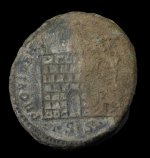The reverse looks to be in good condition too, and I can see some specs of silver from the weak silver covering that was applied to these coins, but has since worn off.
The reverse shows a campgate (watchtower) with two signal beacons.The legend reads PROVIDENTIAE AVGG which translates as "The foresight of the emperors". The exergue reads "ΓSIS" meaning the 3rd (gamma) officina (workshop) of the Siscia (SIS) mint, located in modern day Sisak Croatia. The character "Γ" is the Greek character for 3 - gamma.
“PROVIDENTIAE AVGG”. This translates to “In honor of the foresight of the Emperors”.

Actually I have not revealed the last part of the legend which i am assuming here is "AVGG". If, however, it reads "CAESS" then it refers to providence to the the two princes, and thus the coin would be from Constantine's son Constantine II. Once I finish the legend on the reverse, or the obverse I will know. They both made this same coin at the same time.
The campgate motif is one that appears in Roman coinage and continues in some form into later Western European coinage. The campgate motif became popular in Roman coinage in the 4th century, and the photo below is typical of these gates - generally a gate set in a wall/tower surmounted by turrets (or beacons). The surviving gate at Trier (Germany) allows us to see the commonalties between the reality and the coin. The Trier campgate, surviving today, was essentially the entrance to a fortified area and not a part of a transient camp.
